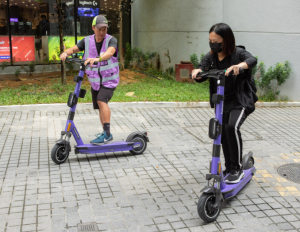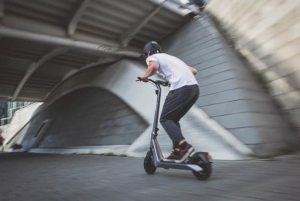No, it’s unsafe for three people to ride an electric scooter due to weight limits and stability issues.
Introduction
Electric scooters have gained popularity as a convenient and eco-friendly mode of transportation. They are lightweight, easy to operate, and offer a quick way to navigate through city streets. However, the rise in their usage has also raised concerns regarding their safety, especially when used by multiple riders.
Overview of Electric Scooters
Electric scooters are powered by a rechargeable battery and can reach speeds of up to 25 km/h. They are designed for single riders, but it’s not uncommon to see two or more people riding one scooter. This practice, though, can lead to safety issues due to the scooter’s limited weight capacity and design.
Safety Concerns for Multiple Riders
When multiple riders use an electric scooter, it increases the risk of accidents due to:
- Weight Overload: Most electric scooters have a weight limit of around 100-120 kg. Exceeding this limit can affect the scooter’s balance and braking system, making it more prone to tipping over.
- Reduced Maneuverability: With more weight, the scooter becomes less agile, making it harder to navigate around obstacles or make sudden turns.
- Increased Stopping Distance: The added weight also increases the stopping distance, which can lead to collisions if the rider is not able to brake in time.
To address these concerns, manufacturers and regulatory bodies have set guidelines for the safe use of electric scooters, including recommended weight limits and safety gear requirements. It’s crucial for riders to adhere to these guidelines to ensure their safety and the safety of others on the road.
Legal Regulations
The legal regulations for electric scooters vary by region, but most places have specific laws regarding maximum occupancy and safety gear requirements to ensure the safety of riders and pedestrians.
Maximum Occupancy Laws
Maximum occupancy laws for electric scooters are set to prevent overloading and ensure the safety of riders. These laws typically specify that electric scooters are designed for single riders and prohibit carrying passengers. For example, in California, the Vehicle Code Section 21235 states that no person shall operate an electric scooter with any passengers in addition to the operator. Violating these laws can result in fines and other penalties.
Safety Gear Requirements
Safety gear requirements for electric scooter riders are also regulated by law. Commonly required safety gear includes:
- Helmets: Many regions mandate the use of helmets for riders of all ages or for those under a certain age (e.g., under 18 years old).
- Reflective Clothing: To increase visibility, some laws require riders to wear reflective clothing or have reflective elements on the scooter, especially when riding at night.
- Lights: Front and rear lights are often required for riding in low-light conditions to ensure that the scooter is visible to other road users.
Failing to comply with these safety gear requirements can result in fines and increased risk of injury in the event of an accident. It’s essential for riders to familiarize themselves with and adhere to the local regulations to ensure their safety and avoid legal repercussions.
Risks for Three Riders
Carrying three riders on an electric scooter significantly increases the risk of accidents due to weight distribution issues and maneuverability challenges.
Weight Distribution Issues
The design of electric scooters is optimized for a single rider, with a specific weight limit usually ranging from 100 to 120 kg. When three riders are on board, the combined weight often exceeds this limit, leading to several problems:
- Reduced Stability: The extra weight can shift the scooter’s center of gravity, making it less stable and more prone to tipping over, especially during turns or on uneven surfaces.
- Braking Inefficiency: The braking system of a scooter is designed for a certain weight load. With excess weight, the braking distance increases, raising the risk of collisions.
- Structural Stress: Continuous overloading can cause wear and tear on the scooter’s frame and components, potentially leading to mechanical failures.
Maneuverability Challenges
Maneuverability is crucial for safely navigating through traffic and avoiding obstacles. However, with three riders, maneuverability is compromised:
- Limited Control: The additional weight affects the scooter’s handling, making it harder to steer and navigate, especially at higher speeds or in tight spaces.
- Decreased Response Time: The extra mass reduces the scooter’s responsiveness to rider inputs, such as turning or braking, increasing the likelihood of accidents.
- Increased Risk of Injury: In the event of a crash or sudden stop, the likelihood of injury is higher for all riders due to the cramped space and lack of proper seating.
Overall, carrying three riders on an electric scooter poses significant safety risks due to compromised weight distribution and maneuverability. It is advisable to adhere to the manufacturer’s recommendations and local laws regarding maximum occupancy to ensure safe riding.
Safety Measures
Adopting appropriate safety measures is crucial for minimizing the risks associated with riding electric scooters, especially when carrying multiple riders.
Recommended Protective Gear
Wearing the right protective gear can significantly reduce the risk of injury in the event of an accident:
- Helmets: A helmet is the most important piece of safety gear. It should fit properly and meet safety standards such as CPSC for bicycles or ASTM F1492 for skateboarding.
- Knee and Elbow Pads: These pads provide additional protection for the knees and elbows, which are vulnerable in a fall.
- Gloves: Gloves protect the hands from abrasions and improve grip on the handlebars.
- Reflective Clothing: Wearing reflective clothing or adding reflective tape to the scooter enhances visibility to other road users, especially at night.
Best Practices for Multiple Riders
While it’s generally recommended to avoid carrying multiple riders on an electric scooter, if it’s necessary, the following best practices should be followed:
- Follow Weight Limits: Ensure that the combined weight of the riders does not exceed the scooter’s maximum weight capacity.
- Positioning: The primary rider should be in control of the scooter, with additional riders positioned as close to the center as possible to maintain balance.
- Slow Down: Reduce speed to improve stability and increase reaction time to navigate safely.
- Avoid Sudden Movements: Sudden turns or stops can easily unbalance the scooter, so it’s important to make gradual movements.
Adhering to these safety measures and best practices can help mitigate the risks associated with carrying multiple riders on an electric scooter.

